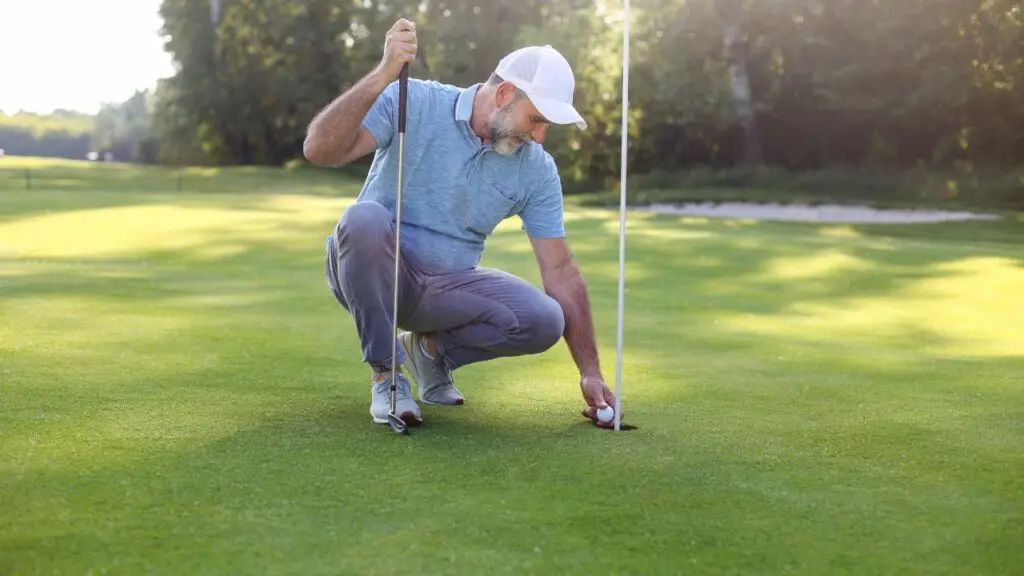Mastering the Hole in One: The Exhilarating Golf Achievement
- Last updated on July 1, 2023
- Toni Benedito
- Golf Courses, Blog
A hole in one in golf is a coveted achievement that occurs when a golfer manages to land the ball directly into the cup with a single stroke from the tee. This feat is an amalgamation of precision, skill, luck, and understanding various factors, including wind direction, green condition, and your stance. Celebrated with traditions and bringing indelible joy, a hole-in-one is a special milestone in any golfer’s journey, cherished in the game’s lore.

One of the most exciting moments in golf for any golfer is hitting a hole-in-one. For those who are not familiar with this term, a hole-in-one occurs when a golfer hits the ball directly into the cup with a single stroke. The significance of achieving a hole in one cannot be overstated. It’s an accomplishment that requires both skill and luck, and it’s something that every golfer dreams of achieving at least once in their lifetime. The excitement of hitting such an elusive shot is hard to explain but easy to understand once experienced.
To make a hole-in-one, golfers must aim for the pin area on the green from the tee box or fairway. The pin area is typically located towards the center of the green and marked with a flagstick to indicate its location. Golfers must hit their ball accurately to land it close to or directly in this area. Achieving this feat takes more than just hitting hard; it demands precise control over speed, direction, and spin when striking the ball. Making contact with errant shots may result in displaced grass or turf chunks on either side of your shot line. Several factors play into making this shot successful: Wind direction and speed, green slope, shape, and condition; stance, balance, and posture when striking—all need consideration as they affect how well you can focus on fast-tracking your golf transport toward granting passage through each stroke until accomplishing that ultimate experience!
"One of the most exciting moments in golf for any golfer is hitting a hole-in-one."
If you’re lucky enough to achieve a hole-in-one on your own or while playing with friends, family members, coworkers, etc., there are several golfing traditions you should follow after completing this incredible accomplishment! These include ringing bells atop some holes at some courses as well as shouting out a caution cry, “Fore!” when a golf ball may be flying towards another player. It’s common courtesy to allow other golfers to play through if you’re taking longer than usual on the green. A hole-in-one is an incredible achievement for any golfer that requires skill, precision, and a bit of luck.
It’s an experience that leaves an indelible mark on one’s memory and contributes to their well-being as they continue to play the game they love. Whether you’re an amateur or a professional golfer, making this shot is always something special that should be cherished and celebrated!
Definition of a Hole in One
“Hole in one“ is a term that is widely known in the sport of golf. It refers to a shot made by a golfer where the ball lands directly into the cup with one stroke on a par-3 hole. In other words, it is like hitting a bullseye in darts or shooting an arrow straight to the center of the target. A hole-in-one is considered one of the most prestigious achievements in golf, and it brings along with it a sense of pride and accomplishment for every golfer. The concept of a “hole in one” dates back to the early days of golf history, here you can find out what other terms are commonly used is golf that you need to know.
The term was first coined around 1869, when an amateur golfer named Thomas Golfus hit his ball directly into the hole from 100 yards away at Prestwick Golf Club. Since then, this feat has been celebrated as every golfer’s ultimate goal. Making a hole in one might seem easy, but it requires precision, skill, and luck. The ball must travel through various obstacles such as water hazards, bunkers, or rough terrain before it reaches its destination.
"To make a hole-in-one, golfers must aim for the pin area on the green from the tee box or fairway. The pin area is typically located towards the center of the green and marked with a flagstick to indicate its location. Golfers must hit their ball accurately to land it close to or directly in this area. Achieving this feat takes more than just hitting hard; it demands precise control over speed, direction, and spin when striking the ball. "
Golfers need to have perfect timing, accuracy, and speed while swinging their clubs to achieve this feat. When playing golf, there is no greater feeling than hearing a warning shout from your fellow players followed by cheers as you watch your ball land straight into the pin area on your tee shot. It’s like you’ve just struck gold! You feel elated with joy knowing that you hit your ball well enough that no one can find it again—not even those who tend to lose their balls quite often!
Achieving a hole-in-one requires skillful execution combined with good fortune; many factors must align perfectly for this momentous event to take place. However, when all these factors come together just right—ground impact feels solidly smooth beneath your feet; caution cries are silenced by awe-inspired gasps—there’s nothing more satisfying than knowing you’ve just accomplished a feat that few golfers ever experience.

How to Achieve a Hole in One
Achieving a hole-in-one is the ultimate goal for any golfer, and it requires a perfect combination of skill, concentration, and a little bit of luck. Here are some important things to keep in mind if you want to get that elusive hole-in-one:
Firstly, you need to have good technique and swing mechanics. This means having proper alignment, grip pressure, and tempo in your golfing motion. Before attempting it, it’s important to practice on the driving range or hitting golf balls on the green area so that you can develop your skills and improve your chances.
Secondly, distance control is very important when aiming for one. You need to know how far you can hit each club so that you can pick the right one for the shot. It’s also important to take into account factors like wind speed and direction, which can affect how far your ball will travel.
Thirdly, accuracy is key when aiming for one. You need to be able to hit the ball precisely where you want it to go, which ideally would be straight towards the pin area without any deviation off your target line towards a greenside bunker or fairway hazard. Straying off course with wayward shots will only decrease your chances of achieving this feat.
Getting a hole-in-one requires concentration and focus, which implies avoiding all sorts of management-related distractions such as misplaced balls or allowing faster players behind too much within their motorized cart without giving way, especially when playing with other golfers who might not be striving for this same goal.
Achieving this is no easy feat, but by focusing on techniques such as perfecting distance control skills, aiming accurately toward pin areas while taking wind speed and directions into account, and avoiding distractions from other golfers around like sand bunkers, sand traps, warnings, cries, etc., you will increase your odds of success significantly!
Famous Hole in Ones in History
Some of the most memorable moments in golf have been hole-in-ones made by professional and amateur players alike. These aces, as they’re commonly called, mark one of the most exciting and rare events in golf. Over time, some holes have become more famous than others thanks to the number of holes in one that occur there or for other reasons.
One such example is the 16th hole at TPC Scottsdale, which is known for its raucous atmosphere during the Waste Management Phoenix Open. The par-3 hole has a stadium-like design surrounding it with stands that can hold tens of thousands of people. The proximity of fans to the green area often results in loud cheers and sometimes even heckling when a player misses their shot. Despite these distractions, there have been 11 hole-in-ones made on this hole during tournament play.
Another famous instance occurred at Augusta National Golf Club during The Masters tournament. In 1992, Fred Couples hit his tee shot on the par-3 12th hole onto a slope next to Rae’s Creek. As he watched nervously from the tee box, his ball slowly trickled down onto the putting surface and into the cup for an improbable ace. The moment became iconic due to not only how difficult it was to make but also because it helped propel Couples to his first Major championship victory.
A third example comes from across the pond at Carnoustie Golf Links, located in Scotland. During practice rounds for the 1999 Open Championship, Tiger Woods hit his tee shot on the par-3 16th over a bunker and onto the green area, where it rolled straight into the cup for an ace! This incredible feat helped cement Woods’ status as one of golf’s greatest players ever and forever linked him with Carnoustie’s unique challenges.
We cannot forget about amateur golfer Ollie Schniederjans, who made two holes-in-one on consecutive days while playing a practice round at the same hole on the same course with the same golf vehicle. This amazing feat took place during the 2014 U.S. Amateur Championship and helped Schniederjans make a name for himself in the world of golf. These famous hole-in-ones remind us that even the best players need a little luck and that, in golf, anything can happen at any time.
The Odds of Making a Hole in One
The thrill of a hole-in-one is something that every golfer dreams of achieving. But let’s be honest: Making a hole in one is not something that happens every day. In fact, the odds of making one are quite slim—some might even say astronomical!
According to studies done, the odds of an average golfer making a hole-in-one are approximately 12,500 to 1. That’s right—you’re more likely to get struck by lightning or win the lottery than make a hole-in-one! However, if you’re a scratch golfer with some serious skills, your odds improve significantly to about 2,500 to 1.
So what factors affect your chances of making a hole-in-one?
It all comes down to luck and skill. You need the perfect shot and ground impact for the ball to fast-track toward the pin area and safely land on the putting surface without hitting any hazards such as greenside bunkers or water hazards. However, golfers can take certain measures to increase their odds of making a hole-in-one.
"According to studies done, the odds of an average golfer making a hole-in-one are approximately 12,500 to 1."
For example, golf course management is key; choosing courses with smaller greens can increase your chances, as this reduces the target zone while also eliminating any wind variables that could push your ball offline. Some golfers may choose to invest in hole-in-one insurance policies that will pay out if they achieve this rare feat, but others prefer not to take any risks due to high premiums or the belief that it’s tempting fate. Making a hole in one requires not only skill but also luck and sometimes even perfect conditions.
The joy and excitement that come with achieving this rare accomplishment make it all worth it, though! So keep practicing those swings; you never know when you might just hit that perfect shot and hear an alert call from your golfing buddies indicating you’ve made a once-in-a-lifetime shout of precaution: “fore”—because nothing beats a hole-in-one.
Enjoying this article? Read more:

The Impact of a Hole in One
A hole-in-one is a major achievement in golf, and it can have a big impact on the player and those around them. There’s nothing quite like hitting that perfect shot and watching as the ball lands straight in the hole. It’s a one-shot wonder that can change the course of your game, and it can even affect those playing alongside you.
First of all, the impact is emotional. The feeling of hitting the perfect shot and seeing it land where you want it to is indescribable. Golfers work hard to improve their game, and getting this is like reaching the summit of their journey. It’s an exhilarating moment that can make players feel proud, excited, or even emotional. But there are also practical impacts to consider when someone achieves it.
For example, if other players are waiting behind you on the course, they may need to wait while you finish celebrating with your group or retrieve your ball from the hole vicinity. This can cause some delays for other golfers who are trying to play quickly. To prevent this kind of situation from happening frequently or excessively during your rounds, players should always practice safe golf practices and be aware of those around them on the course. One way to do this is by being diligent about alerting others nearby before hitting their club swing by giving a warning shout (such as “fore!”) if their ball could potentially hit someone else’s ball or land near other players.
"If other players are waiting behind you on the course, they may need to wait while you finish celebrating with your group or retrieve your ball from the hole vicinity."
Another practical impact of achieving a hole-in-one has to do with granting passage for faster players behind them on busy courses. Oftentimes, electric buggies (also called “golf vehicles” or “golf carts“) come into play here: they may allow quicker movement across areas such as fairways and help avoid damaging turf chunks when driving over grass, yet they can also cause fairway damage and create piles of sand traps.
This is why golfing precautions are so important, and etiquette plays a key role in the game. A hole in one can have an impact on the player’s scorecard. Depending on how well they were playing before the shot, it could make a big difference in their final score for that round. For instance, if they were having a rough day and struggling to hit good shots before making the hole-in-one, it could give them the motivation they needed to pick up their game and finish strong.
There are many ways that achieving a hole-in-one can have an impact on the player and those around them. Whether it’s emotional or practical, this amazing feat is something that golfers dream of accomplishing throughout their entire careers.
Hole in One Tradition and Etiquette
Achieving a hole-in-one is a momentous occasion for any golfer, which is why it’s important to follow golf course etiquette when celebrating. Hitting the perfect shot is something to be proud of, but it’s also important to remember that you’re not the only one on the golf course.
When celebrating, keep your excitement to a reasonable level and refrain from excessive cheering or shouting. Golf course etiquette also demands that you take care of the putting surface after hitting. Many golfers make the mistake of leaving large turf chunks on the green after their shot, which can hinder other players’ putting experience. Use your putter or foot to fix any damage done by your celebratory jump or dance.
"When celebrating, keep your excitement to a reasonable level and refrain from excessive cheering or shouting."
If you’re playing with others who have yet to hit a hole-in-one, it’s important to avoid gloating or bragging about your achievement. Instead, focus on congratulating them on their own successful shots and sharing tips and tricks for how you achieved your stroke. In addition to personal etiquette, there are also traditions surrounding golf that vary from country club to country club. Some clubs offer albatross pins or plaques for those who achieve this feat, while others may offer free drinks at the clubhouse bar.
If you’re unsure about what traditions exist at your club, be sure to ask around beforehand so you’re prepared when it happens. Overall, achieving a hole-in-one should be celebrated within reason while also respecting other players and following golf course etiquette guidelines. Remember that hitting a hole in one doesn’t grant special privileges when it comes to golfing behavior, such as passage through groups ahead or rushing through play around the hole’s vicinity, just because of your achievement. Keep these tips in mind when celebrating and enjoying this unforgettable moment on the green!

Hole in One Insurance
This is a type of insurance policy that protects golfers from bearing the expenses of the traditional hole-in-one prize. The prize, which is usually a brand-new car, vacation, or cash, can be expensive and beyond the budget scope of most golf clubs. This insurance covers the expenses of the prize if a golfer makes a hole-in-one during an event. The cost of this insurance varies depending on factors such as the number of players participating, the prize value, and how many holes are insured.
It can cost anywhere from $100 to $1,000 for small events and up to $50,000 for large events with high-value prizes. It’s important to note that Hole in One Insurance isn’t just beneficial for golf clubs but also for sponsors and charities that want to offer prizes at their events.
It reduces their financial risk while making it possible for them to offer exciting prizes without having to worry about breaking their budget. When purchasing hole-in-one insurance, there are certain requirements that must be met. A professional must be present on behalf of the insurer or sponsor to witness any hole-in-one occurrence. The golfer must also comply with all safe golf practices as well as etiquette rules when attempting their shot.
"It can cost anywhere from $100 to $1,000 for small events and up to $50,000 for large events with high-value prizes."
Hole in One Insurance offers peace of mind for golf clubs, sponsors, and charities who want to offer exciting prizes at their events without worrying about breaking their budget. It’s important when taking out this insurance policy that all relevant parties follow proper etiquette and comply with safe golf practices so that everyone can enjoy this exciting moment without any mishaps or accidents occurring on the green!
Conclusion
Making a hole-in-one is the ultimate achievement for any avid golfer. It requires precision, skill, and a bit of luck. The feeling of seeing your ball drop into the cup in one smooth motion is indescribable.
It’s an accomplishment that lasts forever and will be remembered with pride by any golfer lucky enough to achieve it. Moreover, a hole-in-one is not just about individual achievement but also about celebrating with friends and fellow golfers. Traditions such as buying rounds of drinks or donating to charity add to the excitement of this momentous occasion. Golfing manners dictate that when someone makes one, everyone in their group should applaud and congratulate them on their success.
However, it’s important to remember that while making a hole-in-one is exciting, etiquette on the golf course should always be maintained. Golfing rules such as keeping up with the pace of play and repairing turf chunks are crucial for maintaining the security and management of the course. Errant shots can cause accidents if golfers are not paying attention or if someone forgets to give a caution cry when necessary. In addition, while it’s natural to feel frustrated when losing golf balls or ending up in sand bunkers, it’s important to maintain composure and good conduct on the course.
Swearing or throwing clubs can ruin someone’s experience and detract from their enjoyment of the game. Overall, making a hole-in-one is an incredible experience that every golfer dreams of achieving at some point. I have yet to be this fortunate; however, I have not stopped trying.
While it takes skill and hard work to achieve this feat, it also requires patience and perseverance. By maintaining proper etiquette on the course and following golfing rules, every golfer can enjoy their time playing this challenging yet rewarding sport.
FAQs
A hole-in-one in golf is often referred to as an “ace.” So if you hear someone casually saying they scored an “ace” during their round of golf, now you know they’re bragging about a hole-in-one.
It’s one of those things that’s just evolved over time in the language of golf. The term “ace” is used to denote excellence or superiority in many contexts, so it seems fitting that it was adopted in golf to represent the best possible result on any single hole. So when you score a “one,” you’re really scoring an “ace” because you can’t do any better than that!
Well, hitting a hole-in-one means you’ve achieved something pretty extraordinary in golf. In a nutshell, it means you managed to get your golf ball into the hole in just one stroke from the tee box. It’s like scoring a three-pointer in basketball at the buzzer or hitting a home run in baseball – it’s a big deal!
There’s no difference at all. “Ace” and “hole-in-one” are just two different ways to say the same thing in golf. It’s like saying “soda” or “pop,” depending on where you’re from. Both terms describe the amazing feat of sinking your golf ball into the hole with just one stroke from the tee box.
While both are incredibly rare in the world of golf, an albatross, which is three under par on a hole, is generally considered harder to achieve than a hole-in-one. This is because most albatrosses require two perfectly executed shots on a Par 5, while a hole-in-one involves a single great shot on a Par 3. But trust me, either achievement would be the highlight of any golfer’s day!
Yes, a hole-in-one can be made on any par-3 hole. It doesn’t matter if the distance is short or long; it’s all about getting the ball in the cup with one stroke.
There are a few things you can do to increase your chances of making a hole-in-one. First, make sure you’re using the right club for the distance and wind conditions. Second, aim for the center of the green to avoid hazards like sand bunkers and water hazards. Focus on your golfing motion and swinging technique to ensure proper contact with the ball.
If you hear an alert call or caution cry from another golfer, immediately stop your golfing behavior and give way to them until they have completed their shot. This is especially important if you’re driving a golf vehicle, like a motorized cart.
Always be courteous and offer help if your ball ends up causing any damage or disruption. You should also take golfing precautions by shouting out a precautionary shout before hitting your shot so others can be aware of where your ball might go.
When entering or leaving greenside bunkers, always use appropriate caution and keep an eye out for other players who may be playing nearby. Be sure to rake up any golfing divots that were made when exiting so that others won’t have difficulty with their shots later on.
Share this post
Toni Benedito
Keep Reading
Follow Us
Recent Posts

How Do Pro Golfers Get Paid? The Business of Golf
Professional golfers get paid both before and after tournaments. Before a tournament, they receive appearance fees, sometimes exceeding $1 million, to attract top players. After the tournament, earnings depend on their placement, with the PGA

How Much Do Golf Players And Pros Make? You Won’t Believe It!
Professional golfers earn substantial incomes through tournament winnings, sponsorship deals, and endorsements. Top players on the PGA Tour can make millions annually, with significant earnings from prize money and lucrative brand partnerships. For example, Rory

The Shocking Cost: How Much Does It Cost to Fly with Golf Clubs?
Flying with golf clubs can be a hassle, but it’s worth it for avid golfers. Costs vary by airline, ranging from $30 to $150 per way. Southwest Airlines offers a generous policy, allowing one set

Why Do Golfers Tape Their Fingers Before Hitting the Course?
Golfers tape their fingers to prevent injuries from repetitive motions, provide support for existing injuries, and improve grip comfort. It’s a popular technique among amateurs and pros alike, offering a lightweight and effective solution compared

How Much Does a Round of Golf Cost? Are You on Par?
The cost of a round of golf varies widely based on factors like course type, location, and time of play. Public courses typically range from $30-$100 per round, while exclusive ones like Augusta National or

Hidden Fees: How Much Does It Cost To Rent a Golf Cart
Wondering how much it costs to rent a golf cart? Explore factors like location, rental duration, and cart type impacting prices. Daily rates range from $50 to $80, while weekly rentals can vary from $200
Table of Contents







